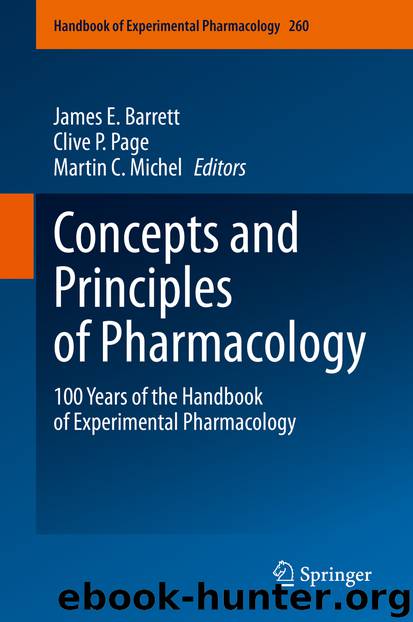Concepts and Principles of Pharmacology by James E. Barrett & Clive P. Page & Martin C. Michel

Author:James E. Barrett & Clive P. Page & Martin C. Michel
Language: eng
Format: epub
ISBN: 9783030353629
Publisher: Springer International Publishing
Keywords
Biomedical engineeringDevelopmental biologyDrug discovery and developmentImage-based modellingMechanistic modellingModelling and simulationModel informed drug development
D.M. is employed by Bayer AG, Wuppertal, Germany.
S.T. is employed by Cyfex AG, Z膧rich, Switzerland.
The opinions expressed in this manuscript are those of the authors and do not necessarily reflect the views of their employers.
1 Introduction
A mathematical model is a simplified and formalised description of a real-world system. As real-world systems are inherently complex, in particular biological systems, mathematical models typically focus only on certain aspects of system composition and/or behaviour. Theoretical analysis of an adequately established mathematical model provides insight into properties and behaviour of a real-world system it represents. Due to the complexity of real-world systems, their mathematical models are also complex, and their analysis is conducted numerically on a computer giving rise to computational modelling. Development and application of computational models can be roughly classified as “scientifically” motivated with a goal of gaining novel insight into the mechanisms governing system behaviour, and “engineeringly” motivated with a goal to forecast a system’s behaviour under certain conditions. “Scientifically” motivated modelling typically precedes engineering applications; the latter are employed to optimise problems which are qualitatively understood. In any case, a mechanistic computational model requires substantial knowledge about the inner mechanics of the system, as well as exact values (or their distributions) of parameters describing system properties, which are often not known and require substantial effort to measure them. For biological systems, measurements can be extremely challenging and time consuming. On the other hand, advances in imaging techniques have led to a rapid growth of available imaging data; for instance, a routine imaging experiment could generate more than 1 terabyte of data (Kherlopian et al. 2008; Chen et al. 2014; Troy and Kris 2017). Extracting biologically relevant, human interpretable knowledge from these large spatio-temporal datasets is challenging due to the lack of adequate tools and sheer size (Myers 2012). Development of spatially resolved computational models based on imaging data gives rise to image-based modelling. The strength of this approach is in that it directly uses imaging data to build, parameterise and validate mechanistic computational models, and it formalises hypothesis testing based on imaging data. Ultimately, it is an effective approach to transform large experimentally acquired datasets into human interpretable knowledge.
In this chapter, we introduce basics of the image-based modelling approach and review its applications in developmental biology and biomedical research as well as for medical device development and drug discovery and development. Examples from developmental biology and basic biomedical research illustrate applications of image-based modelling to gain understanding of mechanisms governing systems behaviour. Other examples demonstrate applications of already established image-based models for medical device and drug development. To facilitate understanding of various application areas of image-based modelling by a diverse audience, we added Sect. 2 with a very brief description of typical mathematical models describing fluid flow, solid mechanics and reaction-diffusion systems, which provide mathematical formalisms for mechanistic image-based modelling. Computational methods for image processing, computational mesh generation, solution of spatially distributed models, etc. are out of scope of this review.
Download
This site does not store any files on its server. We only index and link to content provided by other sites. Please contact the content providers to delete copyright contents if any and email us, we'll remove relevant links or contents immediately.
| Administration & Medicine Economics | Allied Health Professions |
| Basic Sciences | Dentistry |
| History | Medical Informatics |
| Medicine | Nursing |
| Pharmacology | Psychology |
| Research | Veterinary Medicine |
Tuesdays with Morrie by Mitch Albom(4692)
Yoga Anatomy by Kaminoff Leslie(4306)
Science and Development of Muscle Hypertrophy by Brad Schoenfeld(4089)
Bodyweight Strength Training: 12 Weeks to Build Muscle and Burn Fat by Jay Cardiello(3915)
Introduction to Kinesiology by Shirl J. Hoffman(3726)
How Music Works by David Byrne(3187)
Sapiens and Homo Deus by Yuval Noah Harari(2987)
The Plant Paradox by Dr. Steven R. Gundry M.D(2547)
Churchill by Paul Johnson(2506)
Insomniac City by Bill Hayes(2499)
Coroner's Journal by Louis Cataldie(2432)
Hashimoto's Protocol by Izabella Wentz PharmD(2331)
The Chimp Paradox by Peters Dr Steve(2298)
The Universe Inside You by Brian Clegg(2097)
Don't Look Behind You by Lois Duncan(2080)
The Immune System Recovery Plan by Susan Blum(2029)
The Hot Zone by Richard Preston(1983)
Endure by Alex Hutchinson(1964)
Woman: An Intimate Geography by Natalie Angier(1882)
